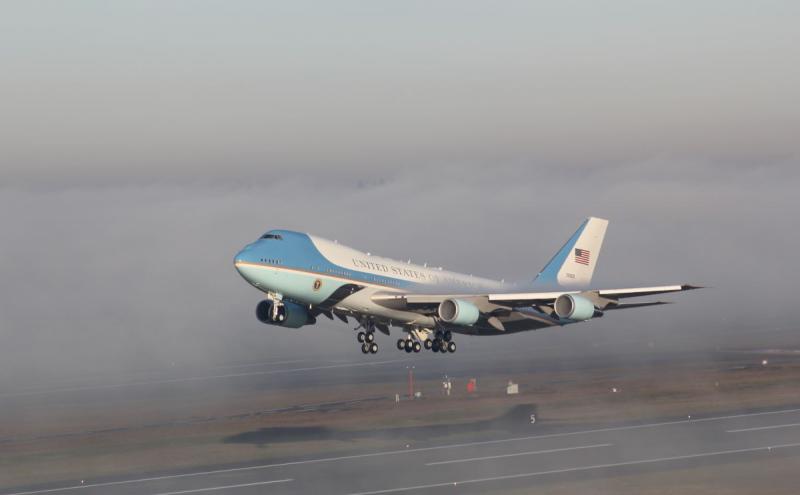Co-authored by Cathy Swift (Port of Seattle) and the Raisbeck Aviation High School Green Energy Team: Maya Peña, Hai Lin Truman, Eric Nguyen, Lucien Freemesser, Timothy Jou, Teddie Blahous, Thomas Kebede, Emily Batig, Alexis Lee, Abby Jawili, and Daniel Sung
Long gone are my days of awkward Science Fair projects made from construction paper or the baking soda exploding volcano. Those seem quaint and lame next to the significant and multi-year efforts of the Raisbeck Aviation High School Green Energy Team. These students are learning about science, technology, engineering, and math (and life) by building and racing a solar-powered race car. Not to mention taking first place around the country.
The team won the popular vote at the Ballard Elks Car show in September 2021, which was just one of their many stops that year, including the Texas Motor Speedway. The Raisbeck Racers are having their day in the sun and learning invaluable skills and life lessons as they go.
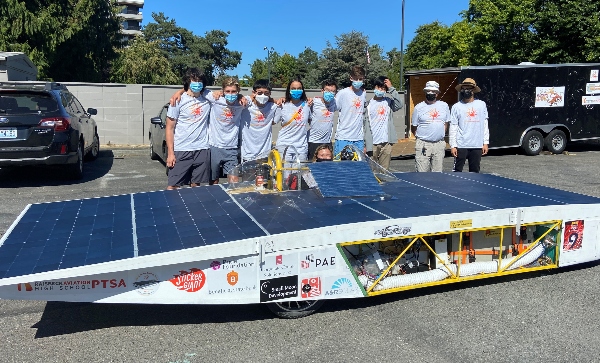
Aviation-themed learning community
Raisbeck Aviation High School has around 400 students focusing on STEM-related topics like aviation, aerospace, engineering, and other related STEM disciplines. The school, in Tukwila, is located behind the Aviation Pavilion of the Museum of Flight and next door to King County International Airport. It’s one of the best STEM schools in the nation and the learning style is inquiry-based with an emphasis on students presenting and defending their work in front of industry experts.
The need for an aviation-themed learning community emerged from industry projects that the aviation industry would continue to grow, and that there would be a local and national shortage of younger, highly trained, and qualified employees.
Port supports STEM
Early in the process, the Port of Seattle provided funding assistance to build the campus building. And now supports the students by holding a yearly academic challenge. Commission President Ryan Calkins has participated as a judge in the competition and echoes the sky-high bar these students are setting in a 2018 blog post.
As a judge of {the 2018} competition, I had the opportunity to evaluate four of the groups’ proposals, which included wastewater recapture, geothermal heating and cooling, living walls, and other sustainability amenities. Not only were the presentations exemplary, but the students were professional and informative. At various points, we panelists had to remind ourselves that these were sophomores, and not college or graduate students!”
Aviation High — which the Port provided a quarter of the building costs for — is a fantastic example of the kind of STEM education that is essential to prepare today’s students for tomorrow’s jobs. While it’s hard to predict exactly what skills will be necessary for tomorrow’s jobs, everyone will need this kind of critical thinking ability to observe, analyze, and make decisions about a process or problem. Whether you are a ship captain determining how best to navigate a storm, an engineer tackling a difficult problem in the design of a new airplane component or a nurse determining the best care for a patient, critical thinking is a key component of success and is the groundwork for a healthy and sustainable economy.”
Raisbeck Racers raring to go
The team demonstrated their collaboration and seamless teamwork by all participating in this interview. These bright, articulate, and enthusiastic students’ words below share their process and mind-boggling achievements far better than I can as translator. They’re the experts of the present and the architects of our future; and IMHO our future will be bright when these brilliant minds take charge.
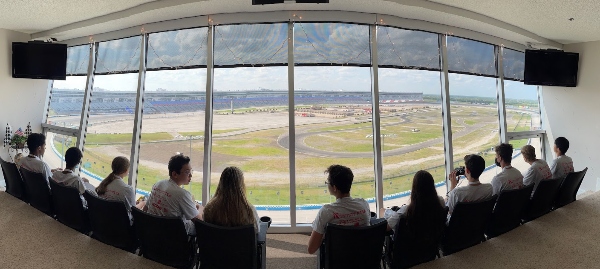
Q: What was the inspiration for building this vehicle? How did you come up with the idea?
Like any engineering exercise, building a solar vehicle is an iterative process and the team has learned and improved every step of the way.
Maya Peña shares a history of the build process and their learnings.
- In 2016-17, the Green Energy Team took four teams to the National KidWind Championship and placed 1st, 2nd, and 4th.
- In 2018, the team competed in the 2018 Collegiate Wind Challenge in Chicago and held their own against 12 college and university teams.
- In 2019 the Green Energy Team embarked on a new challenge: designing and building a solar car from the ground up to compete in the 2019 National Solar Car Challenge held at the Texas Motor Speedway in Dallas Ft. Worth, Texas, and crushed it! Our championship car/team set a new track record for the most laps completed in the history of the competition.
- After the team’s championship win in 2019, the team set out to defend their title in the 2020 National Solar Car Challenge.
- The 2020 competition was ultimately canceled, but the team returned to Texas for the 2021 competition and earned another national championship title
Q: Tell me about the vehicle you built
Hai Lin Truman tells us in detail about the iterative process for building several vehicles and implementing what they learned from every season into the next year's build.
The car that we raced in this year's national championship was a completely new vehicle.
The 2018-19 national champion car was a single-body car with elevated solar panels. It was built for simplicity due to it being our first year in the competition, but it also provided a stable and efficient design. There were however large drawbacks to this design. By elevating the panels above the driver, we would increase the frontal area of the vehicle and thus, increase the aerodynamic drag.
The other problem lay in the accessibility of the car. Our cockpit was built to accommodate a person ranging from 5’4” to 5’10” tall. This meant that there were lots of people on the team who were unable to drive. These would be the aspects of the car we aimed to improve.
In the design phases of the vehicle, we brought the solar panels down to shoulder level. This reduced the frontal area of the car but resulted in a reduction in solar area due to the cockpit. We however believed that the decrease in drag would outweigh the loss in solar area. We also made the entire cockpit adjustable. The pedals could shift forward and back as well as the seat. This meant that everyone on the team could drive the car as well as reap the benefits of their labor.
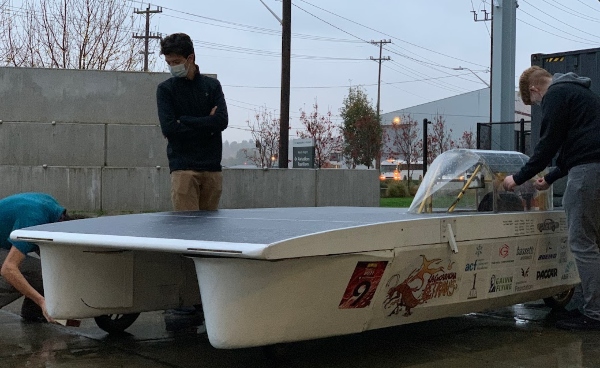
Once the construction of the car began, we decided that the frame of the car would be made out of steel due to its ease of construction (Welding) as well as its incredible strength. This meant that we could weld together a frame quickly and expedite the build process of the car. After the main body had been created, we set our attention on reducing the weight of the shell and also thus reducing the drag. We would go on to use aircraft fabric to seal the shells to once again reduce the weight of the car.
As for the electronics of the car, we learned a lot from the last race. We developed a cruise control system for our vehicle to reduce the loss of power due to driver corrections. When driving by pedal, you are constantly increasing and decreasing in speed. By introducing a cruise control system, we can make the entire system more efficient by eliminating the driver error.
The other major electrical system we have is the incredibly intricate data acquisition system. In our car, we have an Arduino that collects the data from the sensors in many different places. Going from the temperature of the battery all the way to the amount of power being brought in from the solar panels, our strategy team was able to monitor live data from the car at all times. This meant that they were able to make accurate and effective decisions to make the car drive at its most efficient point.
Overall, this year’s car was made to be efficient, aerodynamic, and accessible. Due to these factors, we found incredible success in both the 2018-19 and 2020-21 national solar car challenges.
Q: Tell me a story about something that did not go as planned and what you learned from it.
Eric Nguyen shares the students’ testing and troubleshooting process:
Two weeks before the race at Texas, our motor stopped running. After initially troubleshooting the issue, we were led to believe that the issue resided in the motor controller. After testing two spare motor controllers and a motor controller from our 2019 car, we still couldn’t get the motor to run. Pretty much the whole team was scrambling to try to get it fixed because we have worked on the car for two years and we didn’t want all of our efforts to go to waste. After endless hours of troubleshooting with blood, sweat, and tears, we figured out the problem and solved it. We learned that when everyone has the same goal and drive to accomplish the goal, we can do anything.
Q: Which classes prepared you best for building this vehicle?
Lucien Freemesser details the school curricula that are much more relevant and future-facing than the woodshop, sewing, and home economics classes many of us barely remember.
Being a STEM school, Raisbeck Aviation has provided us with many classes and opportunities that have helped us build the solar car. There are many different parts of a solar car that all require different skills to design and build.
For the mechanical aspects of the car Engineering Design (CAD) is a fantastic class. In CAD, one can learn about 3D modeling and design. We use Autodesk Inventor, which is provided for free by the school, to learn how to design different parts, everyday items, and complex assemblies made up of a multitude of things. Taking this class has helped all of us be able to work through the process of designing and manufacturing different parts for the solar car.
As for the electrical side of the solar car, Digital Electronics is a great course to take. Here, one can learn about many different things related to electronics and microcontrollers. We can build different circuits and create things using an Arduino and we use both of these things on the car. While working on car electronics can be very complicated and confusing for many members, this class lets us have a better understanding of things going on in the world and the solar car.
Being a school centered around aviation, we have access to many connections in the industry. We have reached out to places like Boeing for help in figuring out the best aerodynamic shape for our car. Overall, Raisbeck Aviation provides us with many opportunities to learn more which has immensely helped in the process of building a solar car.
Q: Tell me about the racing team.
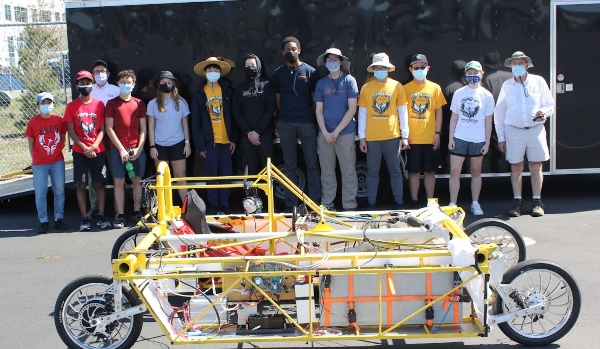
Timothy Jou introduces us to the team in the photo
The Raisbeck Aviation High School Green Energy Team is a group of high school students of all four grade levels (freshmen, sophomores, juniors, seniors), with a shared interest of building solar cars.
We are split into sub-teams consisting of:
- mechanical/structural, which handles the design and execution of the physical components such as the frame, suspension, braking, steering, and aerodynamic body,
- electrical, which handles the electrical components of the car, including the data acquisition system, high voltage relays and connectors, and the battery,
- outreach, which emphasizes the fundraising for the team and managing public relations, and
- strategy, which focuses on the race strategy and determining the most efficient way to drive the car.
Perhaps the most involved/important person on the team is our mentor, Dr. Alain Semet. He contributes his expertise and knowledge of math, physics, electronics, and many other subjects to our team. We would not be where we are today without him. “
Q: What‘s the most valuable thing you have learned from this project?
Teddie Blahous has learned to weld, an incredibly valuable skill that can’t be common in high school students.
My second year on the team, and the old welder of the previous car has moved on to college, leaving me as the new welder on the team. First starting out I was awful. Then after countless videos on YouTube, research, and practice, I was able to improve drastically, enough to teach new team members aspiring to weld. My sophomore and junior year, I was able to contribute a large majority to welding the main chassis of the solar car.
Thomas Kebede says that teamwork has been a big takeaway.
Working together in a cohesive manner. In the evenings and mornings of every race day, the team members would always be ready to put the array stays up (which are meant to angle the array perpendicular to the sun). This was no easy task, as it required the entire team to screw the brackets, place the metal bridge in the car, and lock the extender into place at the angle we desired. Prior to coming to Texas we had very minimal training with putting it up and it took us quite a bit of time, but on the final day of racing we managed to put the array in less than two minutes. The importance of teamwork and our team members being able to cooperate successfully outside of building the car and inside was key to our success in Texas.
Emily Batig has learned about publishing and community outreach
A large focus that our team had was outreach. Our team members both learned how to write monthly blog posts on our blog. In addition, we formed connections with business professionals to learn from them as well as gain inspiration for our project. We also held multiple outreach events to share our progress and successes with the public. Overall, as a team we had to learn how to communicate with many different people which took a fair amount of practice. I also learned about resilience and developed a work ethic under constant pressure; many times we arrived at the Texas Motor Speedway before sunrise and left after sunset.
Alexis Lee is the team captain and is proud of the team’s present and future.
I think the entire team could have agreed this project is absolutely life changing. This project is not like any other science class or club around. High school students are learning functional engineering, and problem solving through the context of solar energy. All students have learned professional skills about fundraising, outreach, presentation, and public speaking. The team has been featured on a number of live news stations about the team’s recent success. We have learned how to work together, depend on each other, and problem solve big problems on the fly. And the team has demonstrated true dedication, pulling nearly 12 hour days in the summer.
This project has launched the futures of these high school students. This club has helped support the admission to Embry Riddle Aeronautical University, Massachusetts Institute of Technology, University of Southern California, and the U.S. Air Force Academy.
Q: Where have you competed and what awards have you won?
These are just a few of the many awards that the team has won:
2018-2019 Season (Our first year)
- 2019 Advanced Division National Solar Car Champions
- Set track new track record for most total miles traveled throughout the race: 659 laps (988.5 mi)
- Order of the Solar Cell; Presented to these extremely special people who believe in high school solar car racing, and the great students who make it happen. Awarded to George Sidles IV
- William Shih Award; Presented to the solar car team displaying the highest level of technological achievement.
2020-2021 Season
- 2021 Advanced Division National Solar Car Champions
- Back to back National Champions!!
- Set new track record for most total miles traveled in one day: 184 laps (276 mi)
- Order of the Solar Cell: Presented to these extremely special people who believe in high school solar car racing, and the great students who make it happen. Awarded to Joseph Nwizgubo, Maya Peña, and Alexis Lee
- William Shih Award: Presented to the solar car team displaying the highest level of technological achievement.
- Siemens Award: The team takes 1st place for the 2020 Solar Car Challenge Video Presentation
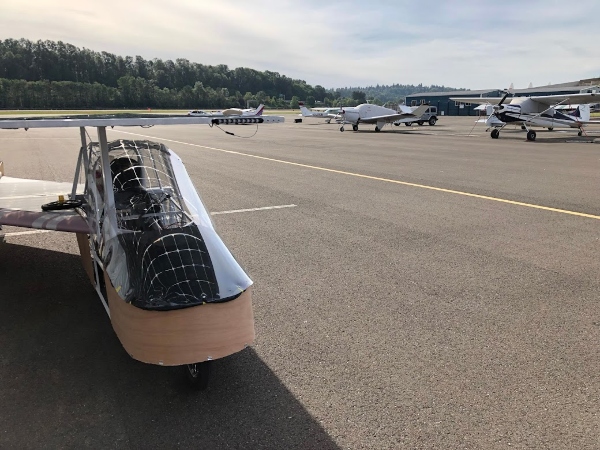
Q: Tell me about Aviation High School and what you like the most.
Abby Jawili thrives with the focused and singular goals of the program.
Raisbeck Aviation high school is a high school that helps students pursue their focuses on STEM-related fields, by focusing on aviation, aerospace, engineering, and other related STEM disciplines. What I like most about Raisbeck is the type of culture that students have built, the sense of community, the willingness to learn, and that students share similar interests of what they would like to pursue in the future.
Daniel Sung loves the community and the warm reception and hopes to pay it forward to new students.
For me personally, I love the community the school has, as well as how inclusive everyone is. I love how everyone gets along and knows each other, even if they're all different grades, as well as how people invite each other to stuff, etc. In my personal experience, when I first joined solar car, I was really blown away by how helpful everyone was, whether it was Lexi telling me about what I could do to get involved, or Alain helping me out with chapter questions. Those experiences honestly helped me understand how close-knit of a community the school is and how everyone is willing to help out. Due to those kinds of experiences, I also hope to help out freshmen who may need help with anything, whether it's finding classes, understanding something, or even just asking for advice. Honestly it's great to see.
You can track the progress of these amazing students:
- Twitter feed @RAHSGreenEnergy
- The team blog
- YouTube channel
- Support the team through donations
Photo credits: Raisbeck Aviation High School Green Energy Team and Cathy Swift

